Construction Technology Report: Hotel Building Design and Construction
VerifiedAdded on 2020/10/22
|14
|4602
|120
Report
AI Summary
This report provides a comprehensive overview of construction technology, focusing on the design and construction of a hotel near Heathrow Airport. It begins by differentiating between residential, commercial, and industrial buildings, emphasizing the specific requirements of a hotel project. The report then explores ways to promote sustainability in building projects, highlighting the importance of energy efficiency, waste management, and the use of renewable equipment. It delves into the terminologies used in hotel construction, followed by a detailed examination of pre-design studies and the selection of suitable foundation types, including deep and shallow foundations. The impact of site information on foundation design is also discussed. Furthermore, the report describes the functional characteristics of superstructure elements such as walls, roofs, and floors, along with their design selection criteria. It also covers site remediation techniques and the supply and distribution arrangements for primary services, including their impact on overall building design. The report concludes with a summary of the key findings and recommendations for the successful construction of the hotel project.

Construction Technology
Paraphrase This Document
Need a fresh take? Get an instant paraphrase of this document with our AI Paraphraser
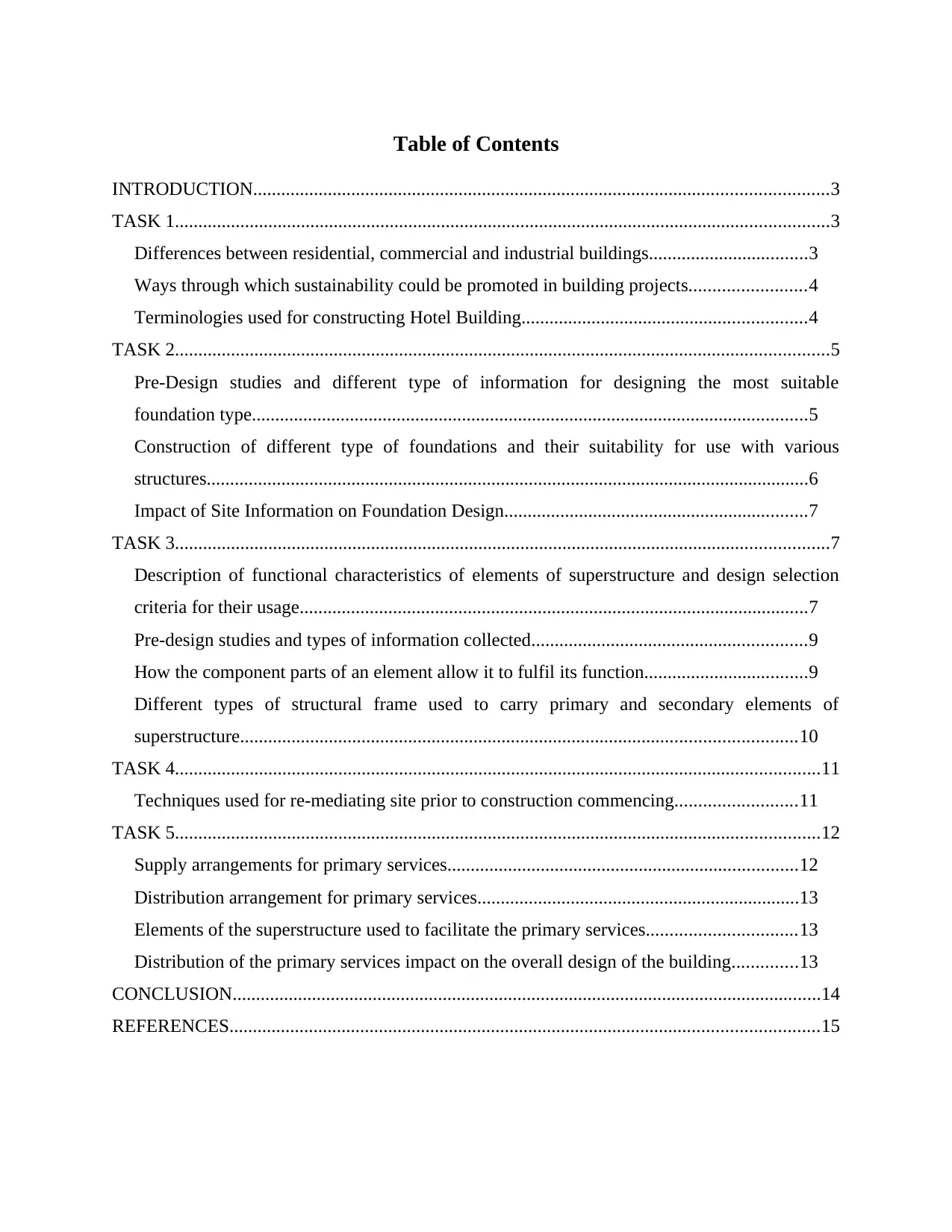
Table of Contents
INTRODUCTION...........................................................................................................................3
TASK 1............................................................................................................................................3
Differences between residential, commercial and industrial buildings..................................3
Ways through which sustainability could be promoted in building projects.........................4
Terminologies used for constructing Hotel Building.............................................................4
TASK 2............................................................................................................................................5
Pre-Design studies and different type of information for designing the most suitable
foundation type.......................................................................................................................5
Construction of different type of foundations and their suitability for use with various
structures.................................................................................................................................6
Impact of Site Information on Foundation Design.................................................................7
TASK 3............................................................................................................................................7
Description of functional characteristics of elements of superstructure and design selection
criteria for their usage.............................................................................................................7
Pre-design studies and types of information collected...........................................................9
How the component parts of an element allow it to fulfil its function...................................9
Different types of structural frame used to carry primary and secondary elements of
superstructure.......................................................................................................................10
TASK 4..........................................................................................................................................11
Techniques used for re-mediating site prior to construction commencing..........................11
TASK 5..........................................................................................................................................12
Supply arrangements for primary services...........................................................................12
Distribution arrangement for primary services.....................................................................13
Elements of the superstructure used to facilitate the primary services................................13
Distribution of the primary services impact on the overall design of the building..............13
CONCLUSION..............................................................................................................................14
REFERENCES..............................................................................................................................15
INTRODUCTION...........................................................................................................................3
TASK 1............................................................................................................................................3
Differences between residential, commercial and industrial buildings..................................3
Ways through which sustainability could be promoted in building projects.........................4
Terminologies used for constructing Hotel Building.............................................................4
TASK 2............................................................................................................................................5
Pre-Design studies and different type of information for designing the most suitable
foundation type.......................................................................................................................5
Construction of different type of foundations and their suitability for use with various
structures.................................................................................................................................6
Impact of Site Information on Foundation Design.................................................................7
TASK 3............................................................................................................................................7
Description of functional characteristics of elements of superstructure and design selection
criteria for their usage.............................................................................................................7
Pre-design studies and types of information collected...........................................................9
How the component parts of an element allow it to fulfil its function...................................9
Different types of structural frame used to carry primary and secondary elements of
superstructure.......................................................................................................................10
TASK 4..........................................................................................................................................11
Techniques used for re-mediating site prior to construction commencing..........................11
TASK 5..........................................................................................................................................12
Supply arrangements for primary services...........................................................................12
Distribution arrangement for primary services.....................................................................13
Elements of the superstructure used to facilitate the primary services................................13
Distribution of the primary services impact on the overall design of the building..............13
CONCLUSION..............................................................................................................................14
REFERENCES..............................................................................................................................15
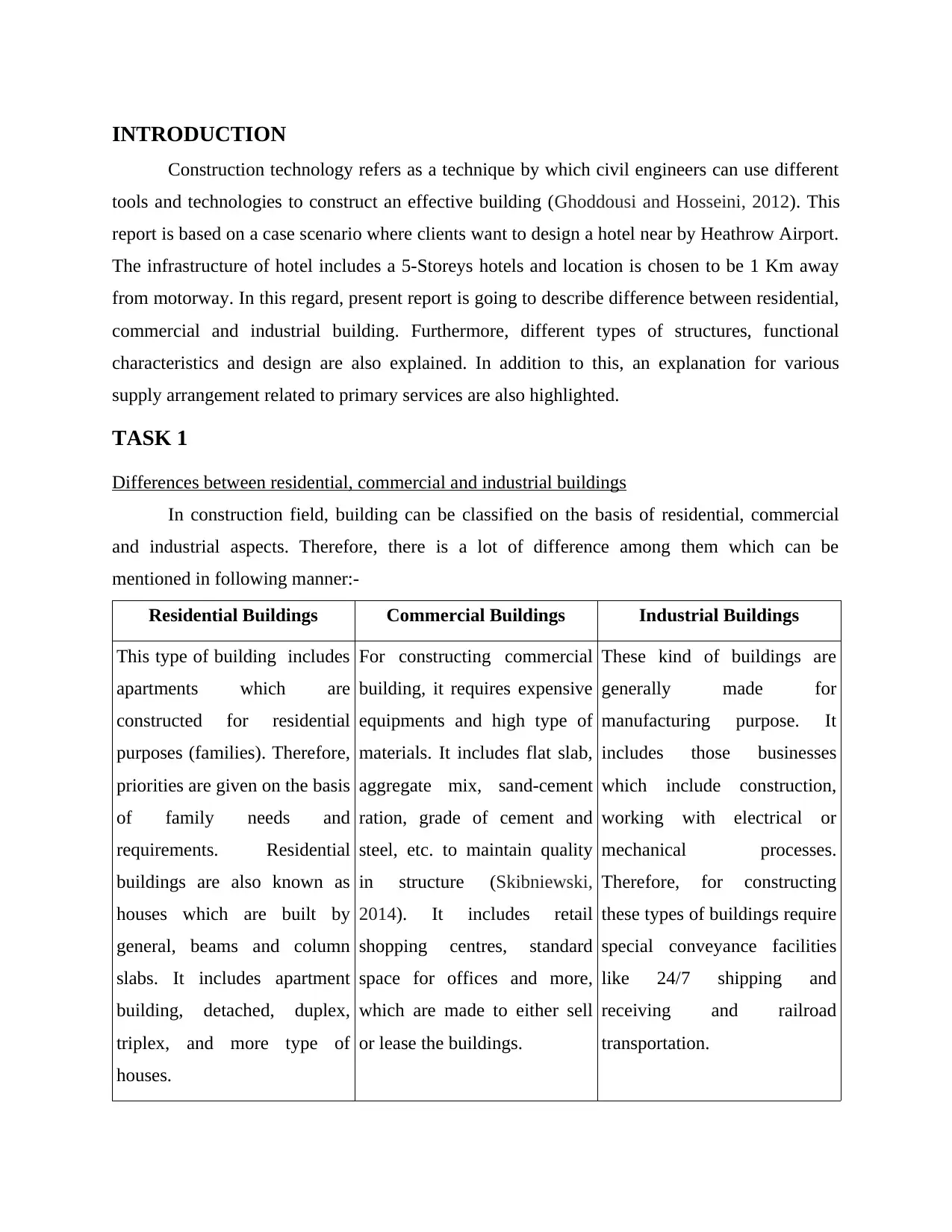
INTRODUCTION
Construction technology refers as a technique by which civil engineers can use different
tools and technologies to construct an effective building (Ghoddousi and Hosseini, 2012). This
report is based on a case scenario where clients want to design a hotel near by Heathrow Airport.
The infrastructure of hotel includes a 5-Storeys hotels and location is chosen to be 1 Km away
from motorway. In this regard, present report is going to describe difference between residential,
commercial and industrial building. Furthermore, different types of structures, functional
characteristics and design are also explained. In addition to this, an explanation for various
supply arrangement related to primary services are also highlighted.
TASK 1
Differences between residential, commercial and industrial buildings
In construction field, building can be classified on the basis of residential, commercial
and industrial aspects. Therefore, there is a lot of difference among them which can be
mentioned in following manner:-
Residential Buildings Commercial Buildings Industrial Buildings
This type of building includes
apartments which are
constructed for residential
purposes (families). Therefore,
priorities are given on the basis
of family needs and
requirements. Residential
buildings are also known as
houses which are built by
general, beams and column
slabs. It includes apartment
building, detached, duplex,
triplex, and more type of
houses.
For constructing commercial
building, it requires expensive
equipments and high type of
materials. It includes flat slab,
aggregate mix, sand-cement
ration, grade of cement and
steel, etc. to maintain quality
in structure (Skibniewski,
2014). It includes retail
shopping centres, standard
space for offices and more,
which are made to either sell
or lease the buildings.
These kind of buildings are
generally made for
manufacturing purpose. It
includes those businesses
which include construction,
working with electrical or
mechanical processes.
Therefore, for constructing
these types of buildings require
special conveyance facilities
like 24/7 shipping and
receiving and railroad
transportation.
Construction technology refers as a technique by which civil engineers can use different
tools and technologies to construct an effective building (Ghoddousi and Hosseini, 2012). This
report is based on a case scenario where clients want to design a hotel near by Heathrow Airport.
The infrastructure of hotel includes a 5-Storeys hotels and location is chosen to be 1 Km away
from motorway. In this regard, present report is going to describe difference between residential,
commercial and industrial building. Furthermore, different types of structures, functional
characteristics and design are also explained. In addition to this, an explanation for various
supply arrangement related to primary services are also highlighted.
TASK 1
Differences between residential, commercial and industrial buildings
In construction field, building can be classified on the basis of residential, commercial
and industrial aspects. Therefore, there is a lot of difference among them which can be
mentioned in following manner:-
Residential Buildings Commercial Buildings Industrial Buildings
This type of building includes
apartments which are
constructed for residential
purposes (families). Therefore,
priorities are given on the basis
of family needs and
requirements. Residential
buildings are also known as
houses which are built by
general, beams and column
slabs. It includes apartment
building, detached, duplex,
triplex, and more type of
houses.
For constructing commercial
building, it requires expensive
equipments and high type of
materials. It includes flat slab,
aggregate mix, sand-cement
ration, grade of cement and
steel, etc. to maintain quality
in structure (Skibniewski,
2014). It includes retail
shopping centres, standard
space for offices and more,
which are made to either sell
or lease the buildings.
These kind of buildings are
generally made for
manufacturing purpose. It
includes those businesses
which include construction,
working with electrical or
mechanical processes.
Therefore, for constructing
these types of buildings require
special conveyance facilities
like 24/7 shipping and
receiving and railroad
transportation.
⊘ This is a preview!⊘
Do you want full access?
Subscribe today to unlock all pages.

Trusted by 1+ million students worldwide

As per current scenario, entrepreneurs seek to make a hotel on motorway sites which is
linked directly with Heathrow Airport. Therefore, it includes both type of buildings viz.
residential and commercial.
Ways through which sustainability could be promoted in building projects
While constructing the building projects, builders must ensure about quality of materials
they are using for construction. As any poor quality may collapsed the building. Therefore, in
this regard, sustainability plays a main role in developing an appropriate infrastructure. As per
UK Green Building Council, near about 10% of CO2 and other harmful gases are emitted from
construction (Tamošaitienė, Zavadskas and Turskis, 2013). In order to reduce this factor, some
ways are given below for promoting sustainability in construction sites:-
Start with energy efficient premises: Since it has been evaluated that much of the
pollution are caused due to construction sites. Therefore, civil engineers and builders are
required to concern on efficient energy management. With this assistance, starting with
some basic tools which are rating with Energy Performance Certificate (EPC) can help in
reducing energy usage. In addition to this, by considering an on-site CHP system i.e.
Combined Heat and Power also helps in making transition towards more renewable
alternatives for traditional site power.
Taking care of construction waste: Wastage in construction contributes the largest
pollutant factor in many countries. It is usually caused due to in-sustainability in building
projects and dispose of wastages. Therefore, it is amendable for builders to concern on
promoting sustainability into an appropriate waste management policy.
Keeping equipment running as efficient as possible: By using high quality of fuels,
cements and other renewable equipments like lubrication can help in reducing carbon
footprint from construction materials. For example: Using small generators for lower
energy demand leads to promote sustainability in construction.
Terminologies used for constructing Hotel Building
According to present scenario, entrepreneurs have given contract to builders for building
a hotel nearby Heathrow Airport (Zhao and et. al., 2015). The location of this hotel has been
selected on either side of airport where a large stream is going parallel to motorway. Therefore,
linked directly with Heathrow Airport. Therefore, it includes both type of buildings viz.
residential and commercial.
Ways through which sustainability could be promoted in building projects
While constructing the building projects, builders must ensure about quality of materials
they are using for construction. As any poor quality may collapsed the building. Therefore, in
this regard, sustainability plays a main role in developing an appropriate infrastructure. As per
UK Green Building Council, near about 10% of CO2 and other harmful gases are emitted from
construction (Tamošaitienė, Zavadskas and Turskis, 2013). In order to reduce this factor, some
ways are given below for promoting sustainability in construction sites:-
Start with energy efficient premises: Since it has been evaluated that much of the
pollution are caused due to construction sites. Therefore, civil engineers and builders are
required to concern on efficient energy management. With this assistance, starting with
some basic tools which are rating with Energy Performance Certificate (EPC) can help in
reducing energy usage. In addition to this, by considering an on-site CHP system i.e.
Combined Heat and Power also helps in making transition towards more renewable
alternatives for traditional site power.
Taking care of construction waste: Wastage in construction contributes the largest
pollutant factor in many countries. It is usually caused due to in-sustainability in building
projects and dispose of wastages. Therefore, it is amendable for builders to concern on
promoting sustainability into an appropriate waste management policy.
Keeping equipment running as efficient as possible: By using high quality of fuels,
cements and other renewable equipments like lubrication can help in reducing carbon
footprint from construction materials. For example: Using small generators for lower
energy demand leads to promote sustainability in construction.
Terminologies used for constructing Hotel Building
According to present scenario, entrepreneurs have given contract to builders for building
a hotel nearby Heathrow Airport (Zhao and et. al., 2015). The location of this hotel has been
selected on either side of airport where a large stream is going parallel to motorway. Therefore,
Paraphrase This Document
Need a fresh take? Get an instant paraphrase of this document with our AI Paraphraser

there are some terminologies given below which are required to understand for construction
technology:-
Mastic: It refers to pasty materials which are used for setting tiles, thermal insulation and
more. As this hotel is going to made near by stream therefore, using mastic helps in
preserving building from moisture.
Construction based software: Using software like CATIA, AutoCAD and more, helps
civil engineers in formulating a proper plan. It acts as a blueprint which is used for
constructing the building in appropriate manner.
Aggregate- It includes crushed stone, water-worn gravel or slag which are available on
different range of size and used for building roofs (waterproofing).
TASK 2
Pre-Design studies and different type of information for designing the most suitable foundation
type
Pre-design is considered as a stage which consists various aspects of designing process. It
includes space required for constructing building sites, timeline, cost and more. Therefore,
owners of hotel require to arrange adequate amount of finance by taking loans from banks or
investors. In this regard, information to design the most suitable foundation can be obtained by:-
Geotechnical study: It is considered as one of the most important part of pre-design study
which undertakes various facts. It includes a detailed information about soil characteristics,
geological conditions and measures geotechnical issues (faulty zones, landslides, earthquake
etc.). Thus, these kinds of reports help civil engineers in choosing the foundation type as per soil
characteristics.
Hydrology Studies: For effectively managing and maintaining the environment, civil
engineers also require to concern about hydrology studies (Eastman, 2018). This would help in
gathering information related to drainage patterns, ground water depth, locations of nearby flood
zone, recharge zones and aquifers, etc. As present hotel is going to make nearby stream where
loamy soil is founded therefore, deep foundation requires to be used. It leads to gain long term
sustainability in construction site.
technology:-
Mastic: It refers to pasty materials which are used for setting tiles, thermal insulation and
more. As this hotel is going to made near by stream therefore, using mastic helps in
preserving building from moisture.
Construction based software: Using software like CATIA, AutoCAD and more, helps
civil engineers in formulating a proper plan. It acts as a blueprint which is used for
constructing the building in appropriate manner.
Aggregate- It includes crushed stone, water-worn gravel or slag which are available on
different range of size and used for building roofs (waterproofing).
TASK 2
Pre-Design studies and different type of information for designing the most suitable foundation
type
Pre-design is considered as a stage which consists various aspects of designing process. It
includes space required for constructing building sites, timeline, cost and more. Therefore,
owners of hotel require to arrange adequate amount of finance by taking loans from banks or
investors. In this regard, information to design the most suitable foundation can be obtained by:-
Geotechnical study: It is considered as one of the most important part of pre-design study
which undertakes various facts. It includes a detailed information about soil characteristics,
geological conditions and measures geotechnical issues (faulty zones, landslides, earthquake
etc.). Thus, these kinds of reports help civil engineers in choosing the foundation type as per soil
characteristics.
Hydrology Studies: For effectively managing and maintaining the environment, civil
engineers also require to concern about hydrology studies (Eastman, 2018). This would help in
gathering information related to drainage patterns, ground water depth, locations of nearby flood
zone, recharge zones and aquifers, etc. As present hotel is going to make nearby stream where
loamy soil is founded therefore, deep foundation requires to be used. It leads to gain long term
sustainability in construction site.
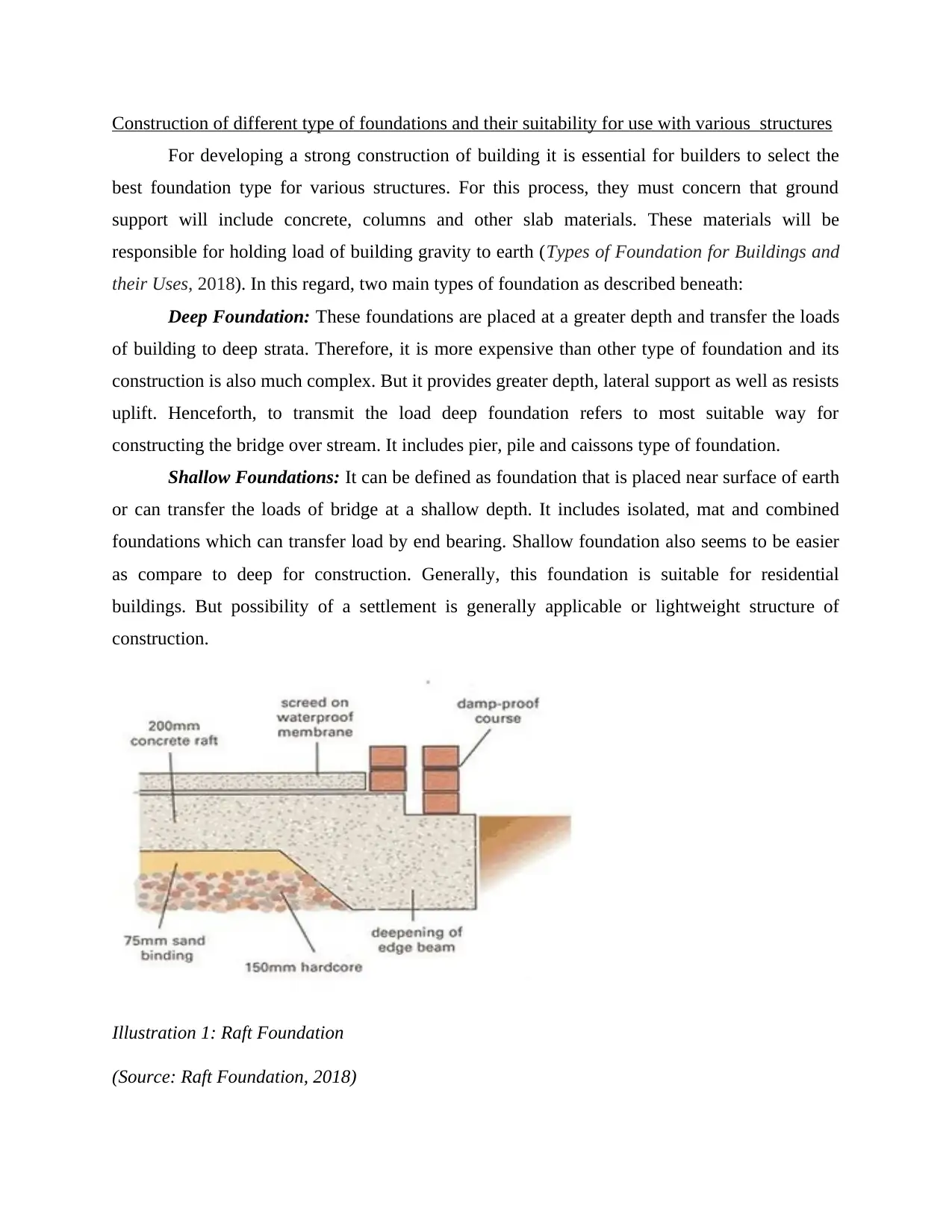
Construction of different type of foundations and their suitability for use with various structures
For developing a strong construction of building it is essential for builders to select the
best foundation type for various structures. For this process, they must concern that ground
support will include concrete, columns and other slab materials. These materials will be
responsible for holding load of building gravity to earth (Types of Foundation for Buildings and
their Uses, 2018). In this regard, two main types of foundation as described beneath:
Deep Foundation: These foundations are placed at a greater depth and transfer the loads
of building to deep strata. Therefore, it is more expensive than other type of foundation and its
construction is also much complex. But it provides greater depth, lateral support as well as resists
uplift. Henceforth, to transmit the load deep foundation refers to most suitable way for
constructing the bridge over stream. It includes pier, pile and caissons type of foundation.
Shallow Foundations: It can be defined as foundation that is placed near surface of earth
or can transfer the loads of bridge at a shallow depth. It includes isolated, mat and combined
foundations which can transfer load by end bearing. Shallow foundation also seems to be easier
as compare to deep for construction. Generally, this foundation is suitable for residential
buildings. But possibility of a settlement is generally applicable or lightweight structure of
construction.
Illustration 1: Raft Foundation
(Source: Raft Foundation, 2018)
For developing a strong construction of building it is essential for builders to select the
best foundation type for various structures. For this process, they must concern that ground
support will include concrete, columns and other slab materials. These materials will be
responsible for holding load of building gravity to earth (Types of Foundation for Buildings and
their Uses, 2018). In this regard, two main types of foundation as described beneath:
Deep Foundation: These foundations are placed at a greater depth and transfer the loads
of building to deep strata. Therefore, it is more expensive than other type of foundation and its
construction is also much complex. But it provides greater depth, lateral support as well as resists
uplift. Henceforth, to transmit the load deep foundation refers to most suitable way for
constructing the bridge over stream. It includes pier, pile and caissons type of foundation.
Shallow Foundations: It can be defined as foundation that is placed near surface of earth
or can transfer the loads of bridge at a shallow depth. It includes isolated, mat and combined
foundations which can transfer load by end bearing. Shallow foundation also seems to be easier
as compare to deep for construction. Generally, this foundation is suitable for residential
buildings. But possibility of a settlement is generally applicable or lightweight structure of
construction.
Illustration 1: Raft Foundation
(Source: Raft Foundation, 2018)
⊘ This is a preview!⊘
Do you want full access?
Subscribe today to unlock all pages.

Trusted by 1+ million students worldwide

In context with hotel construction as per present scenario, it is better to construct mat or
raft foundation. It helps in transferring the load of entire structure of building to deep strata. It
has seen that this type of foundation support load from heavy structures like walls or columns in
deep manner. Therefore, it is better for civil engineers who are going to construct hotel complex
nearby stream to use mat or raft foundation.
Impact of Site Information on Foundation Design
In order to construct the foundation design of Hotel structure, it is very essential for civil
engineers to collect right and accurate amount of data related to site. As if any discrepancy in
measuring the soil characteristic will increase chance of collapse of respective building. In
context with London, here mostly buildings are situated nearby sea levels. Therefore, there is a
huge chance of demolishing the foundation of building (Wong and et. al., 2013). In this regard,
Hydrological and geological study helps in measuring the water level and soil patterns and other
measures. Since hotel is said to be constructed on either side of Heathrow Airport, therefore, on
such location there will be an intense vibrations in land because of aircraft take off and landings.
This kind of information is required to be concerned by civil engineers while constructing
desired hotel. Similarly, concept of raft and matt foundation give advantage to builders to build
effective foundation for transferring load into deep strata. Along with this, building needs to
concern on legislations related to avoidance of any kind ground digging or other kind of
activities, that may affect longevity of hotel complex. Thus, obtaining information about
environmental legislations help in promoting sustainability in construction site also.
TASK 3
Description of functional characteristics of elements of superstructure and design selection
criteria for their usage
Superstructure can be defined as a structure which is developed above the foundation.
The type of superstructure for constructing a bridge can be varied as per range of factors i.e.
from maintenance consideration to personal preference. In context with building a hotel
complex, superstructure includes following elements:-
Walls: It is constructed with a wide range of blocks, concrete, bricks and stones. The
external side of walls separate it from inside and enclose adequate space also. The
characteristic of walls is that it resists damp penetration. The design criteria of walls for
raft foundation. It helps in transferring the load of entire structure of building to deep strata. It
has seen that this type of foundation support load from heavy structures like walls or columns in
deep manner. Therefore, it is better for civil engineers who are going to construct hotel complex
nearby stream to use mat or raft foundation.
Impact of Site Information on Foundation Design
In order to construct the foundation design of Hotel structure, it is very essential for civil
engineers to collect right and accurate amount of data related to site. As if any discrepancy in
measuring the soil characteristic will increase chance of collapse of respective building. In
context with London, here mostly buildings are situated nearby sea levels. Therefore, there is a
huge chance of demolishing the foundation of building (Wong and et. al., 2013). In this regard,
Hydrological and geological study helps in measuring the water level and soil patterns and other
measures. Since hotel is said to be constructed on either side of Heathrow Airport, therefore, on
such location there will be an intense vibrations in land because of aircraft take off and landings.
This kind of information is required to be concerned by civil engineers while constructing
desired hotel. Similarly, concept of raft and matt foundation give advantage to builders to build
effective foundation for transferring load into deep strata. Along with this, building needs to
concern on legislations related to avoidance of any kind ground digging or other kind of
activities, that may affect longevity of hotel complex. Thus, obtaining information about
environmental legislations help in promoting sustainability in construction site also.
TASK 3
Description of functional characteristics of elements of superstructure and design selection
criteria for their usage
Superstructure can be defined as a structure which is developed above the foundation.
The type of superstructure for constructing a bridge can be varied as per range of factors i.e.
from maintenance consideration to personal preference. In context with building a hotel
complex, superstructure includes following elements:-
Walls: It is constructed with a wide range of blocks, concrete, bricks and stones. The
external side of walls separate it from inside and enclose adequate space also. The
characteristic of walls is that it resists damp penetration. The design criteria of walls for
Paraphrase This Document
Need a fresh take? Get an instant paraphrase of this document with our AI Paraphraser
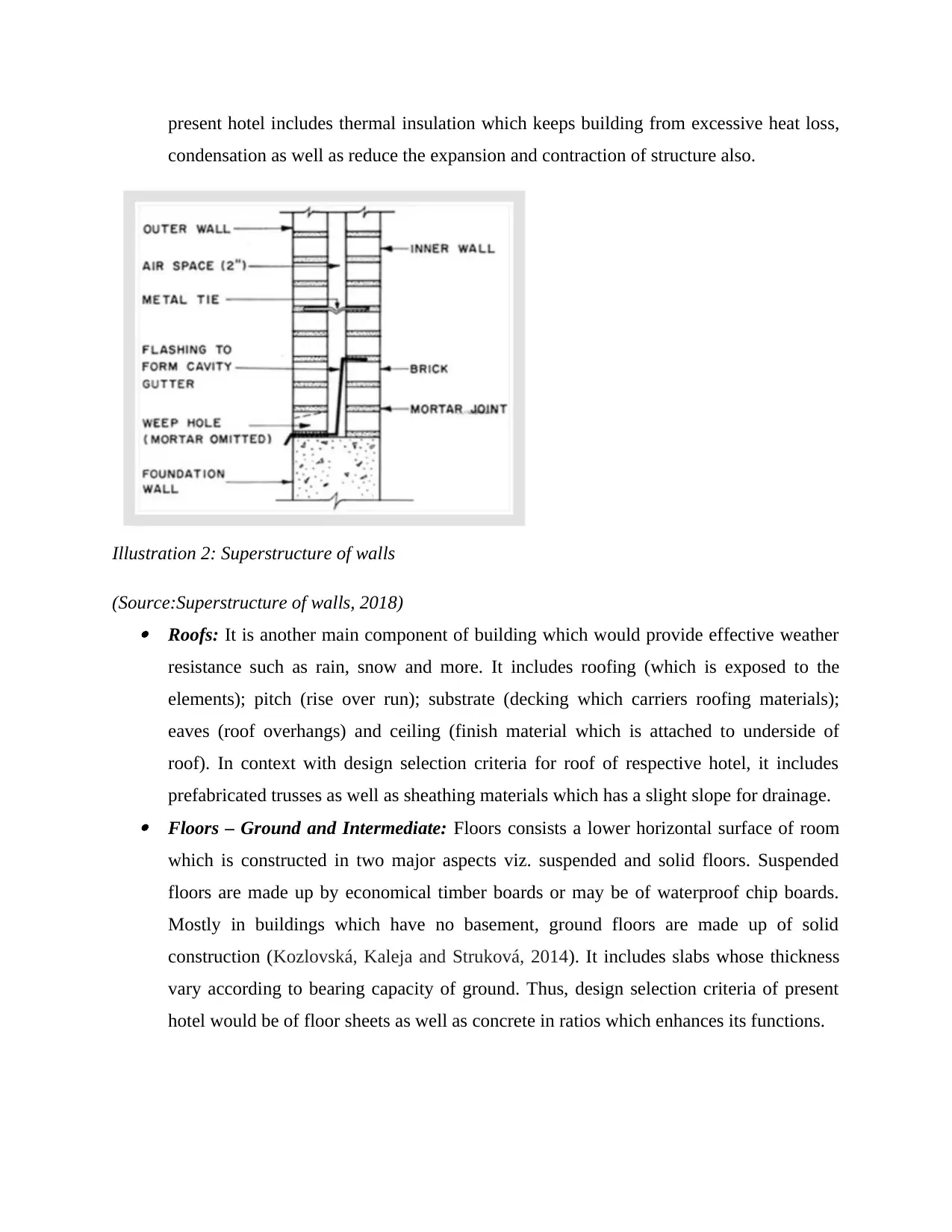
present hotel includes thermal insulation which keeps building from excessive heat loss,
condensation as well as reduce the expansion and contraction of structure also.
Illustration 2: Superstructure of walls
(Source:Superstructure of walls, 2018) Roofs: It is another main component of building which would provide effective weather
resistance such as rain, snow and more. It includes roofing (which is exposed to the
elements); pitch (rise over run); substrate (decking which carriers roofing materials);
eaves (roof overhangs) and ceiling (finish material which is attached to underside of
roof). In context with design selection criteria for roof of respective hotel, it includes
prefabricated trusses as well as sheathing materials which has a slight slope for drainage. Floors – Ground and Intermediate: Floors consists a lower horizontal surface of room
which is constructed in two major aspects viz. suspended and solid floors. Suspended
floors are made up by economical timber boards or may be of waterproof chip boards.
Mostly in buildings which have no basement, ground floors are made up of solid
construction (Kozlovská, Kaleja and Struková, 2014). It includes slabs whose thickness
vary according to bearing capacity of ground. Thus, design selection criteria of present
hotel would be of floor sheets as well as concrete in ratios which enhances its functions.
condensation as well as reduce the expansion and contraction of structure also.
Illustration 2: Superstructure of walls
(Source:Superstructure of walls, 2018) Roofs: It is another main component of building which would provide effective weather
resistance such as rain, snow and more. It includes roofing (which is exposed to the
elements); pitch (rise over run); substrate (decking which carriers roofing materials);
eaves (roof overhangs) and ceiling (finish material which is attached to underside of
roof). In context with design selection criteria for roof of respective hotel, it includes
prefabricated trusses as well as sheathing materials which has a slight slope for drainage. Floors – Ground and Intermediate: Floors consists a lower horizontal surface of room
which is constructed in two major aspects viz. suspended and solid floors. Suspended
floors are made up by economical timber boards or may be of waterproof chip boards.
Mostly in buildings which have no basement, ground floors are made up of solid
construction (Kozlovská, Kaleja and Struková, 2014). It includes slabs whose thickness
vary according to bearing capacity of ground. Thus, design selection criteria of present
hotel would be of floor sheets as well as concrete in ratios which enhances its functions.
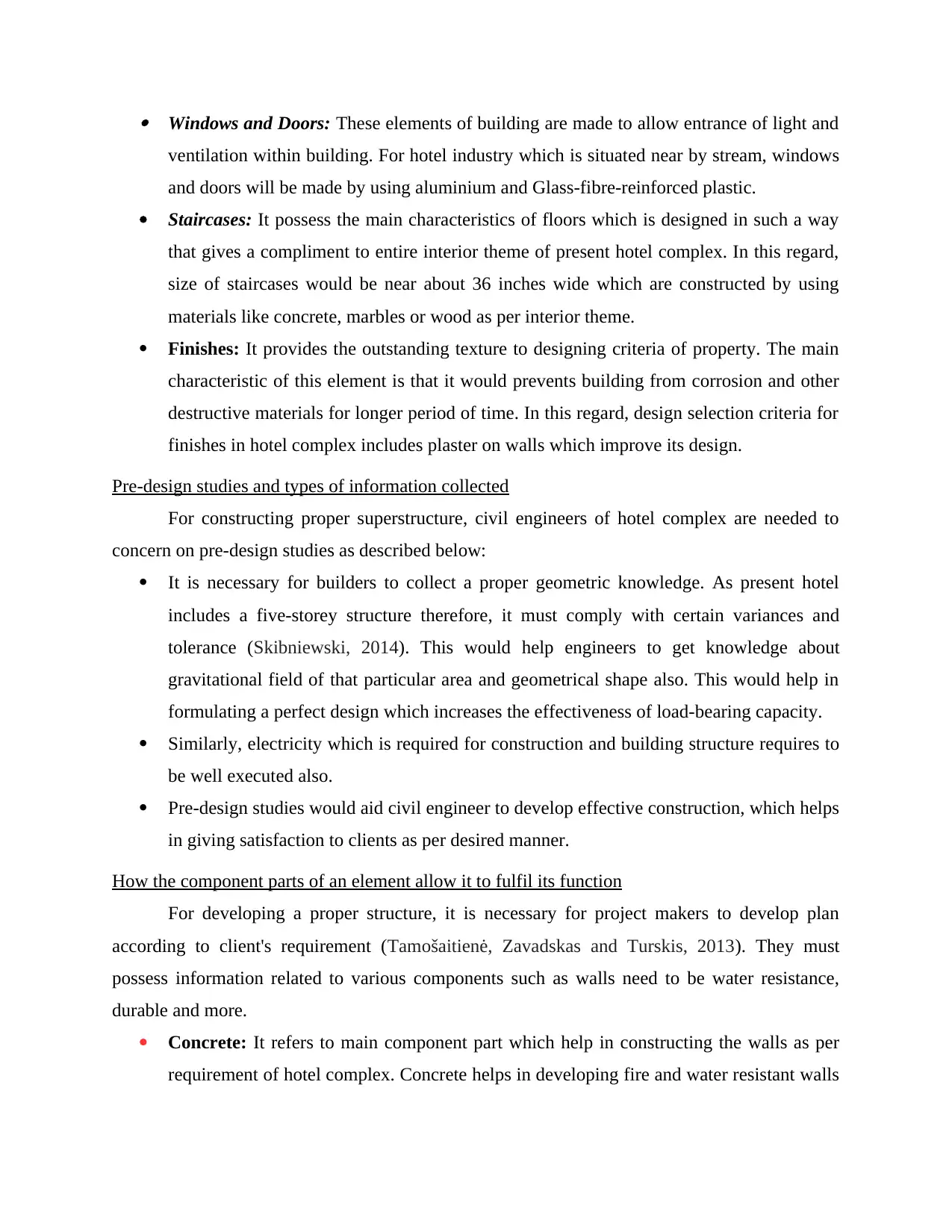
Windows and Doors: These elements of building are made to allow entrance of light and
ventilation within building. For hotel industry which is situated near by stream, windows
and doors will be made by using aluminium and Glass-fibre-reinforced plastic.
Staircases: It possess the main characteristics of floors which is designed in such a way
that gives a compliment to entire interior theme of present hotel complex. In this regard,
size of staircases would be near about 36 inches wide which are constructed by using
materials like concrete, marbles or wood as per interior theme.
Finishes: It provides the outstanding texture to designing criteria of property. The main
characteristic of this element is that it would prevents building from corrosion and other
destructive materials for longer period of time. In this regard, design selection criteria for
finishes in hotel complex includes plaster on walls which improve its design.
Pre-design studies and types of information collected
For constructing proper superstructure, civil engineers of hotel complex are needed to
concern on pre-design studies as described below:
It is necessary for builders to collect a proper geometric knowledge. As present hotel
includes a five-storey structure therefore, it must comply with certain variances and
tolerance (Skibniewski, 2014). This would help engineers to get knowledge about
gravitational field of that particular area and geometrical shape also. This would help in
formulating a perfect design which increases the effectiveness of load-bearing capacity.
Similarly, electricity which is required for construction and building structure requires to
be well executed also.
Pre-design studies would aid civil engineer to develop effective construction, which helps
in giving satisfaction to clients as per desired manner.
How the component parts of an element allow it to fulfil its function
For developing a proper structure, it is necessary for project makers to develop plan
according to client's requirement (Tamošaitienė, Zavadskas and Turskis, 2013). They must
possess information related to various components such as walls need to be water resistance,
durable and more.
Concrete: It refers to main component part which help in constructing the walls as per
requirement of hotel complex. Concrete helps in developing fire and water resistant walls
ventilation within building. For hotel industry which is situated near by stream, windows
and doors will be made by using aluminium and Glass-fibre-reinforced plastic.
Staircases: It possess the main characteristics of floors which is designed in such a way
that gives a compliment to entire interior theme of present hotel complex. In this regard,
size of staircases would be near about 36 inches wide which are constructed by using
materials like concrete, marbles or wood as per interior theme.
Finishes: It provides the outstanding texture to designing criteria of property. The main
characteristic of this element is that it would prevents building from corrosion and other
destructive materials for longer period of time. In this regard, design selection criteria for
finishes in hotel complex includes plaster on walls which improve its design.
Pre-design studies and types of information collected
For constructing proper superstructure, civil engineers of hotel complex are needed to
concern on pre-design studies as described below:
It is necessary for builders to collect a proper geometric knowledge. As present hotel
includes a five-storey structure therefore, it must comply with certain variances and
tolerance (Skibniewski, 2014). This would help engineers to get knowledge about
gravitational field of that particular area and geometrical shape also. This would help in
formulating a perfect design which increases the effectiveness of load-bearing capacity.
Similarly, electricity which is required for construction and building structure requires to
be well executed also.
Pre-design studies would aid civil engineer to develop effective construction, which helps
in giving satisfaction to clients as per desired manner.
How the component parts of an element allow it to fulfil its function
For developing a proper structure, it is necessary for project makers to develop plan
according to client's requirement (Tamošaitienė, Zavadskas and Turskis, 2013). They must
possess information related to various components such as walls need to be water resistance,
durable and more.
Concrete: It refers to main component part which help in constructing the walls as per
requirement of hotel complex. Concrete helps in developing fire and water resistant walls
⊘ This is a preview!⊘
Do you want full access?
Subscribe today to unlock all pages.

Trusted by 1+ million students worldwide
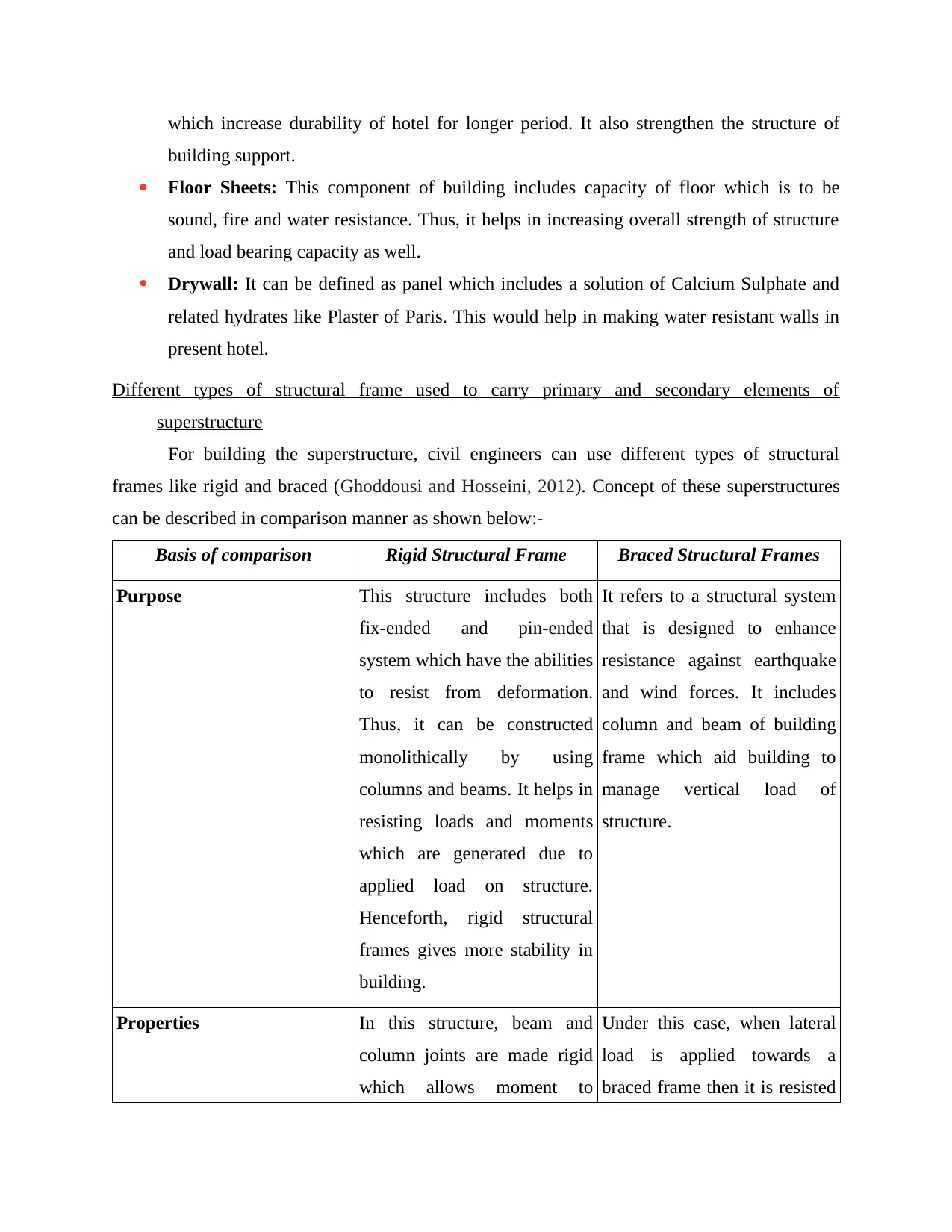
which increase durability of hotel for longer period. It also strengthen the structure of
building support.
Floor Sheets: This component of building includes capacity of floor which is to be
sound, fire and water resistance. Thus, it helps in increasing overall strength of structure
and load bearing capacity as well.
Drywall: It can be defined as panel which includes a solution of Calcium Sulphate and
related hydrates like Plaster of Paris. This would help in making water resistant walls in
present hotel.
Different types of structural frame used to carry primary and secondary elements of
superstructure
For building the superstructure, civil engineers can use different types of structural
frames like rigid and braced (Ghoddousi and Hosseini, 2012). Concept of these superstructures
can be described in comparison manner as shown below:-
Basis of comparison Rigid Structural Frame Braced Structural Frames
Purpose This structure includes both
fix-ended and pin-ended
system which have the abilities
to resist from deformation.
Thus, it can be constructed
monolithically by using
columns and beams. It helps in
resisting loads and moments
which are generated due to
applied load on structure.
Henceforth, rigid structural
frames gives more stability in
building.
It refers to a structural system
that is designed to enhance
resistance against earthquake
and wind forces. It includes
column and beam of building
frame which aid building to
manage vertical load of
structure.
Properties In this structure, beam and
column joints are made rigid
which allows moment to
Under this case, when lateral
load is applied towards a
braced frame then it is resisted
building support.
Floor Sheets: This component of building includes capacity of floor which is to be
sound, fire and water resistance. Thus, it helps in increasing overall strength of structure
and load bearing capacity as well.
Drywall: It can be defined as panel which includes a solution of Calcium Sulphate and
related hydrates like Plaster of Paris. This would help in making water resistant walls in
present hotel.
Different types of structural frame used to carry primary and secondary elements of
superstructure
For building the superstructure, civil engineers can use different types of structural
frames like rigid and braced (Ghoddousi and Hosseini, 2012). Concept of these superstructures
can be described in comparison manner as shown below:-
Basis of comparison Rigid Structural Frame Braced Structural Frames
Purpose This structure includes both
fix-ended and pin-ended
system which have the abilities
to resist from deformation.
Thus, it can be constructed
monolithically by using
columns and beams. It helps in
resisting loads and moments
which are generated due to
applied load on structure.
Henceforth, rigid structural
frames gives more stability in
building.
It refers to a structural system
that is designed to enhance
resistance against earthquake
and wind forces. It includes
column and beam of building
frame which aid building to
manage vertical load of
structure.
Properties In this structure, beam and
column joints are made rigid
which allows moment to
Under this case, when lateral
load is applied towards a
braced frame then it is resisted
Paraphrase This Document
Need a fresh take? Get an instant paraphrase of this document with our AI Paraphraser

transfer joints. Therefore, due
to rigid joint, lateral load from
each storey of building is
transferred with some moment.
by bracing.
TASK 4
Techniques used for re-mediating site prior to construction commencing.
There are numerous ways in which engineers can achieve re-mediation:
Biological treatment: Biodegradation helps in breaking down organic compounds
(Sargent, Hyland and Sawang, 2012). This process is used by civil engineers in bio-
remedication techniques which help in hydrocarbon contaminants.
Chemical treatment: There are various techniques that can be used for chemical
treatment such as:
▪ Chemical Immobilization: It is a complex process and executed by various
treatment chemicals that are present in soil. Saturation of chemical solution with
soil is very important and uses soluble chemicals.
▪ Oxidation: It is an effective chemical treatment that allows elimination or
removal of both toxicity as well as value of contaminants.
Types of substructures works required for the infrastructures
There are a variety of substructures available that help in effective conduction of
construction. Propping: It is a method which deals with providing primary support to structure and its
adjacent properties as well during construction.
Groundwork: It is an overall process related to substructures which involves bulk and
sequence excavations, probing , trimming and so on (Guo, Yu and Skitmore, 2017). It
generally focusses on construction of sub structures or sub surfaces which leads to
beginning of construction process.
Superstructure, Substructure and Civil Engineering Structures necessary for Hotel Complex
For maintaining effectiveness in construction process of a Hotel Complex, it is very
essential that engineer is well versed with superstructure, substructure and other civil
engineering structures. All these structures are defined below:
to rigid joint, lateral load from
each storey of building is
transferred with some moment.
by bracing.
TASK 4
Techniques used for re-mediating site prior to construction commencing.
There are numerous ways in which engineers can achieve re-mediation:
Biological treatment: Biodegradation helps in breaking down organic compounds
(Sargent, Hyland and Sawang, 2012). This process is used by civil engineers in bio-
remedication techniques which help in hydrocarbon contaminants.
Chemical treatment: There are various techniques that can be used for chemical
treatment such as:
▪ Chemical Immobilization: It is a complex process and executed by various
treatment chemicals that are present in soil. Saturation of chemical solution with
soil is very important and uses soluble chemicals.
▪ Oxidation: It is an effective chemical treatment that allows elimination or
removal of both toxicity as well as value of contaminants.
Types of substructures works required for the infrastructures
There are a variety of substructures available that help in effective conduction of
construction. Propping: It is a method which deals with providing primary support to structure and its
adjacent properties as well during construction.
Groundwork: It is an overall process related to substructures which involves bulk and
sequence excavations, probing , trimming and so on (Guo, Yu and Skitmore, 2017). It
generally focusses on construction of sub structures or sub surfaces which leads to
beginning of construction process.
Superstructure, Substructure and Civil Engineering Structures necessary for Hotel Complex
For maintaining effectiveness in construction process of a Hotel Complex, it is very
essential that engineer is well versed with superstructure, substructure and other civil
engineering structures. All these structures are defined below:
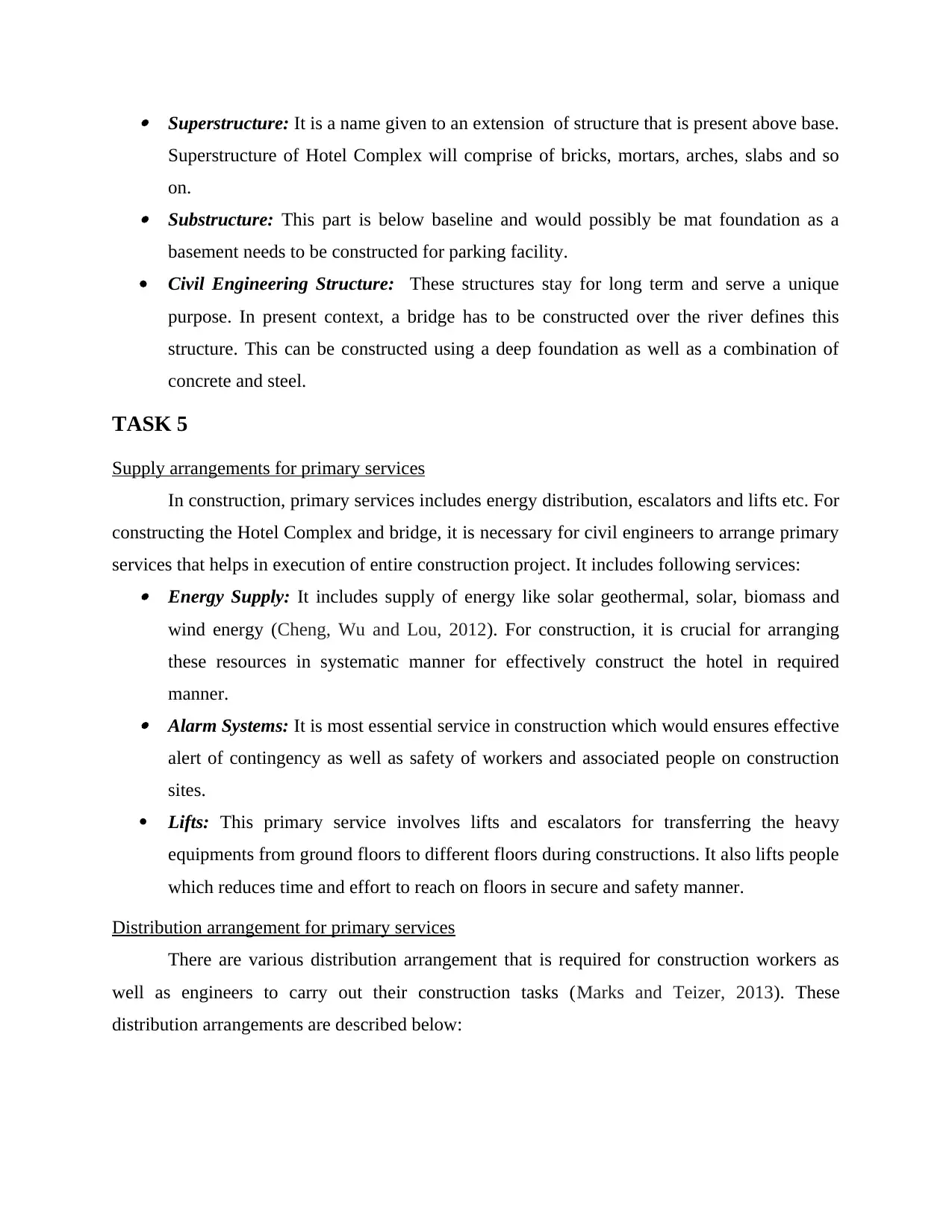
Superstructure: It is a name given to an extension of structure that is present above base.
Superstructure of Hotel Complex will comprise of bricks, mortars, arches, slabs and so
on. Substructure: This part is below baseline and would possibly be mat foundation as a
basement needs to be constructed for parking facility.
Civil Engineering Structure: These structures stay for long term and serve a unique
purpose. In present context, a bridge has to be constructed over the river defines this
structure. This can be constructed using a deep foundation as well as a combination of
concrete and steel.
TASK 5
Supply arrangements for primary services
In construction, primary services includes energy distribution, escalators and lifts etc. For
constructing the Hotel Complex and bridge, it is necessary for civil engineers to arrange primary
services that helps in execution of entire construction project. It includes following services: Energy Supply: It includes supply of energy like solar geothermal, solar, biomass and
wind energy (Cheng, Wu and Lou, 2012). For construction, it is crucial for arranging
these resources in systematic manner for effectively construct the hotel in required
manner. Alarm Systems: It is most essential service in construction which would ensures effective
alert of contingency as well as safety of workers and associated people on construction
sites.
Lifts: This primary service involves lifts and escalators for transferring the heavy
equipments from ground floors to different floors during constructions. It also lifts people
which reduces time and effort to reach on floors in secure and safety manner.
Distribution arrangement for primary services
There are various distribution arrangement that is required for construction workers as
well as engineers to carry out their construction tasks (Marks and Teizer, 2013). These
distribution arrangements are described below:
Superstructure of Hotel Complex will comprise of bricks, mortars, arches, slabs and so
on. Substructure: This part is below baseline and would possibly be mat foundation as a
basement needs to be constructed for parking facility.
Civil Engineering Structure: These structures stay for long term and serve a unique
purpose. In present context, a bridge has to be constructed over the river defines this
structure. This can be constructed using a deep foundation as well as a combination of
concrete and steel.
TASK 5
Supply arrangements for primary services
In construction, primary services includes energy distribution, escalators and lifts etc. For
constructing the Hotel Complex and bridge, it is necessary for civil engineers to arrange primary
services that helps in execution of entire construction project. It includes following services: Energy Supply: It includes supply of energy like solar geothermal, solar, biomass and
wind energy (Cheng, Wu and Lou, 2012). For construction, it is crucial for arranging
these resources in systematic manner for effectively construct the hotel in required
manner. Alarm Systems: It is most essential service in construction which would ensures effective
alert of contingency as well as safety of workers and associated people on construction
sites.
Lifts: This primary service involves lifts and escalators for transferring the heavy
equipments from ground floors to different floors during constructions. It also lifts people
which reduces time and effort to reach on floors in secure and safety manner.
Distribution arrangement for primary services
There are various distribution arrangement that is required for construction workers as
well as engineers to carry out their construction tasks (Marks and Teizer, 2013). These
distribution arrangements are described below:
⊘ This is a preview!⊘
Do you want full access?
Subscribe today to unlock all pages.

Trusted by 1+ million students worldwide
1 out of 14